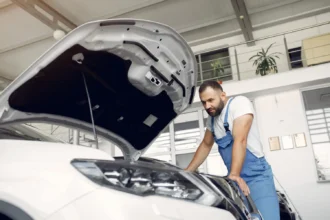Are you ready to discover how cutting-edge car technology is transforming the driving experience? In 2024, car manufacturers are integrating advanced innovations that make driving safer, smarter, and more enjoyable than ever before. If you’re passionate about cars or planning to buy one soon, keeping up with the latest car tech innovations is crucial. In this article, we’ll dive into the top 10 car tech innovations you need to know about, and trust us—these are more than just cool gadgets. They’re revolutionizing the way we drive and interact with vehicles!
1. Autonomous Driving Systems
Self-driving cars have been in development for years, but the technology is now more accessible to consumers. Autonomous driving systems are becoming a regular feature in luxury cars and high-end models. These systems use a combination of cameras, sensors, and AI to help the car navigate, park, and even drive in certain conditions without driver intervention.
How Does It Work?
Autonomous cars rely on LIDAR (Light Detection and Ranging), cameras, and radar to detect their surroundings. They map the environment in real time, allowing them to react to road conditions and avoid collisions. Some cars are equipped with Level 2 automation, where the vehicle controls acceleration, braking, and steering but still requires human supervision.
Benefits:
- Reduces the risk of human error
- Improves fuel efficiency by optimizing routes
- Enables safer road experiences during long drives
2. Advanced Driver Assistance Systems (ADAS)
Another important innovation is Advanced Driver Assistance Systems (ADAS). ADAS includes features like lane-keeping assistance, adaptive cruise control, blind-spot monitoring, and emergency braking. These features make driving more convenient and significantly reduce the likelihood of accidents.

Key Features of ADAS:
- Lane Departure Warning: Alerts you when you’re unintentionally drifting from your lane.
- Adaptive Cruise Control: Automatically adjusts speed to maintain a safe distance from the car in front.
- Automatic Emergency Braking: The car will automatically brake if a collision is imminent and the driver fails to react.
Benefits:
- Enhanced driver safety
- Reduced chances of collisions
- Helps drivers maintain focus on the road
3. Vehicle-to-Everything (V2X) Communication
Imagine a world where your car communicates with other vehicles and traffic infrastructure. Vehicle-to-Everything (V2X) communication technology is making that vision a reality. V2X allows vehicles to share information about speed, traffic conditions, and potential hazards with other vehicles and even traffic signals.
Types of V2X Communication:
- V2V (Vehicle-to-Vehicle): Cars can share information to avoid accidents and reduce traffic congestion.
- V2I (Vehicle-to-Infrastructure): Vehicles interact with traffic lights, road signs, and more to receive real-time updates.
Benefits:
- Reduced traffic congestion
- Improved fuel efficiency through real-time traffic management
- Safer road conditions by alerting drivers to hazards ahead
4. Electric Vehicle (EV) Technology
Electric vehicles are no longer a niche product; they’re taking over the automotive industry. With brands like Tesla, Rivian, and major car manufacturers embracing EVs, the shift toward electric is accelerating.
Key Components:
- Battery Technology: Innovations in lithium-ion batteries are improving range and charging speeds.
- Regenerative Braking: EVs use this feature to convert kinetic energy back into battery power when braking.
Benefits:
- Zero emissions and environmentally friendly
- Lower running costs compared to gasoline cars
- Government incentives in many countries
5. Augmented Reality Dashboards
Traditional dashboards are being replaced with Augmented Reality (AR) Dashboards, which project essential driving information onto the windshield. This technology is called Heads-Up Display (HUD) and provides real-time navigation, speed, and hazard detection without distracting the driver.
How It Works:
Using a transparent display on the windshield, AR dashboards project navigation, speed, and even information about surrounding cars into the driver’s line of sight.
Benefits:
- Enhances driver focus by reducing the need to look away from the road
- Provides real-time, easy-to-read information
- Creates a futuristic driving experience
6. Car-to-Home Integration
Your car is now more connected to your home than ever. Car-to-home integration allows drivers to control smart home devices directly from their vehicle. You can lock your doors, adjust the thermostat, or even turn on lights as you’re pulling into the driveway.
How It Works:
Using voice assistants like Amazon Alexa or Google Assistant, you can manage smart home features while in the car.
Benefits:
- Convenience of controlling home devices on the go
- Enhanced security by remotely managing home systems
- Seamless integration between vehicle and home tech
7. Biometric Vehicle Access
Forget about keys or even your smartphone. Biometric access allows you to unlock and start your car using fingerprint or facial recognition. This technology enhances vehicle security and personalizes the driving experience.
Key Features:
- Fingerprint Scanners: Secure and quick access to the vehicle.
- Facial Recognition: Unlock your car using facial ID for a touchless experience.
Benefits:
- Enhanced security with less risk of theft
- No need for physical keys or devices
- Personalized settings based on user profile (seat adjustment, music, etc.)
8. Solar-Powered Cars
Solar-powered cars are an innovation that’s gaining traction, especially among eco-conscious consumers. These vehicles use solar panels on the roof and other parts of the car to charge the battery, reducing reliance on charging stations.
How It Works:
Solar panels convert sunlight into electrical energy, which powers the car or assists in charging the car’s battery.
Benefits:
- Extends the range of electric vehicles
- Reduces dependency on electric charging stations
- Environmentally friendly energy source
9. Over-the-Air (OTA) Software Updates
Just like your smartphone, your car can now receive Over-the-Air (OTA) updates. These software updates improve performance, add new features, and fix bugs without needing to visit a dealership.
Key Features:
- Remote Software Updates: No need for dealership visits to update vehicle software.
- Feature Enhancements: Cars can gain new functionalities post-purchase.
Benefits:
- Convenience of updates without downtime
- Improved security and performance through regular updates
- Ability to add new features and improvements over time
10. Self-Parking Technology
Parallel parking can be stressful, but self-parking technology makes it effortless. Modern cars now come equipped with self-parking features that automatically maneuver your car into tight parking spots with minimal driver input.
How It Works:
Using sensors and cameras, the car detects the available parking space and automatically steers itself into the spot while the driver controls the speed.
Benefits:
- Eliminates the stress of parallel parking
- Ideal for urban environments where parking is tight
- Increases safety by reducing parking accidents
FAQs on Car Tech Innovations
Q1: Are autonomous cars safe to use today?
A: Autonomous driving systems have advanced significantly, and while they aren’t completely driverless yet, they do enhance safety by reducing human error. Features like automatic braking and lane assistance are now standard in many vehicles.
Q2: How do augmented reality dashboards improve driving?
A: AR dashboards project real-time information directly into the driver’s field of view, helping them keep their eyes on the road while still accessing important navigation or speed details.
Q3: Do electric vehicles cost more to maintain?
A: Generally, EVs have fewer moving parts, meaning less maintenance compared to gasoline-powered cars. There’s no need for oil changes, and the brake systems usually last longer.
Q4: Can I add smart home integration to any car?
A: Not all cars are equipped with the necessary technology, but many modern vehicles, especially luxury models, are compatible with smart home systems like Google Home or Amazon Alexa.
Q5: How does V2X technology benefit traffic?
A: V2X communication allows cars to share data with other vehicles and traffic infrastructure, which can reduce traffic jams, improve fuel efficiency, and enhance road safety by predicting and avoiding accidents.









